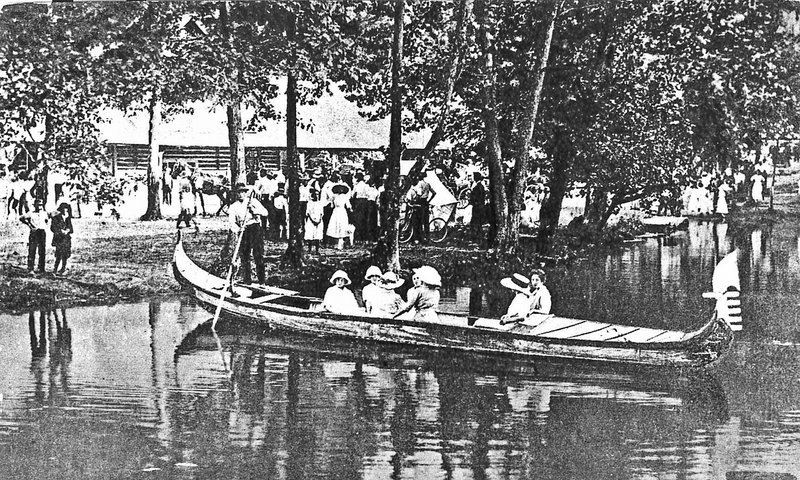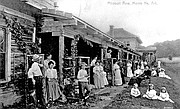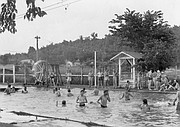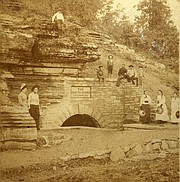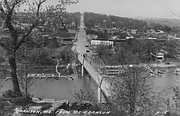On a cruise ship, all the entertainment a tourist could possibly want comes together under one roof -- or so they promise. There's food, entertainment, swimming, afternoons at the spa and evenings spent dancing and making new friends from all over the country. There are even "adrenaline-fueled" activities like surfing, skydiving and ropes courses for the adventurous.
Would you be surprised to know that the Arkansas and Missouri Ozarks were that kind of destination vacation spot from the turn of the 20th century until the 1960s?
As another school year begins with "what I did on my summer vacation" essays, Our Town looks back on the simpler times when families spent the summer -- or at least two weeks of it -- at resorts like Monte Ne, Eureka Springs, Bella Vista and Branson.
Monte Ne
"Until the late 1800s, only the leisure class could afford or even think about vacations," Allyn Lord, director of the Shiloh Museum of Ozark History in Springdale, begins the story. "After the ravages of the Civil War and the difficulties of Reconstruction, Americans of even limited means began to read about wilderness adventures and the rise of 'rustic' hotels, and newspapers began to run stories about such pursuits and places.
"By 1875 the Adirondacks in upstate New York were booming, and the American vacation was born," she continues. "At the same time, transportation improved, so remote destinations became easily accessible by steamboat and train. This combination of physical, economic and social improvements led to the popularization of a new phenomenon: resort hotels."
According to Lord, these all-inclusive, all-summer resorts enjoyed their zenith around 1900. And in Northwest Arkansas, one of the most popular was Monte Ne, which saw its heyday between 1901 and the mid-teens.
Built in the community once called Silver Springs, Monte Ne came from the imagination of William "Coin" Harvey, whom Lord describes as "a nationally known author, debater and silver proponent who had had enough of the limelight and decided to move to what is now Northwest Arkansas because, as he famously remarked, there were no large cities and no extremely rich people." He purchased 328 acres around Silver Springs with the idea of creating a health resort but, says Lord, "it wasn't long before the resort was less about health and more about tourism and a relaxing, cool place to get away for a vacation.
"For years, area residents had headed to the location for its in-the-valley and ice-cold-springs coolness, before the time of widespread electricity for fans," Lord explains. "Harvey capitalized on that amenity by building tourist-related accommodations."
Lord says visitors stayed a few days, a few weeks and sometimes the whole summer. What was it like? She shares part of Harvey's description from 1902:
"And what is there to do at Monte Ne? Well, to start with, there are charming walks and drives and rides. A good livery service is maintained, with comfortable carriages and sure-footed, easy-gaited saddle horses. Then there are bowling alleys and billiard and pool rooms, and kindred amusements.
"There is a fine swimming pool, 25-by-50 feet, with careful appointments. There is an auditorium with a seating capacity of 500. Here during the season may be heard some of the famous speakers, entertainers and concert people of the day. There is a large dancing pavilion where regular parties are given.
"White River, less than a mile away, affords the best of fishing. It is indeed a poor day when the angler cannot find all the sport he desires here. At night, Monte Ne is a veritable fairyland, with the reflection of myriad lights in the lagoon, the echo of laughter and song as the gondoliers wend their way over the winding waters. The evenings here are made to spend out of doors."
Monte Ne's decline came hand in hand with the rise of the automobile.
"Between 1900 and 1920, Americans went from owning 8,000 cars to owning 8 million. Resorts began to be things of the past," Lord says. "We became a mobile society and have stayed that way."
What remains to be seen of Monte Ne depends, Lord says, on "what time of year you visit, how much rain we've had recently, and how quickly the hands of time are moving." About five miles southeast of Rogers on Beaver Lake, one can see, Lord says:
• A two-story fireplace and partial foundation, stairs and walls of Missouri Row, a large log hotel completed in 1905.
• What's left of Oklahoma Row -- a large log hotel completed in 1908 -- primarily the tower, the building foundation, the basement with storerooms and one room for seasonal help. However, the Army Corps of Engineers, which owns the property, is scheduled to raze the tower and foundation in the very near future.
• A few foundation walls from the first frame hotel (1901), visible when the lake waters are low.
While the Shiloh Museum includes Monte Ne in its collections, the Rogers Historical Museum has permanent exhibits on the resort. It's open 10 a.m. to 5 p.m. Monday through Saturday at 313 S. Second St. in Rogers. Admission is free.
__
Bella Vista
As Monte Ne was winding down, Bella Vista was ramping up. It wasn't the retirement/bedroom community residents know today, but instead a summer resort, open from Memorial Day to Labor Day, says Xyta Lucas, president of the Bella Vista Historical Society, which operates the Bella Vista Historical Museum.
It all started with Lake Bella Vista, constructed in 1915-16 by the Rev. William Baker and his wife, Mary, of Bentonville.
"They thought it would be a nice location for a summer resort," Lucas says. "But after they got the lake built, they couldn't get enough investor interest to proceed, so they sold the lake and surrounding property to the Linebarger brothers in January 1917 -- and they proceeded to open the summer resort in June 1917.
"The Linebargers did a lot of publicity to attract tourists, but their focus really was on selling lots and building cabins for people to come spend the summer," Lucas goes on. "And the people who came here for the summer had plenty of activities to keep them busy. The first pavilion/bath house, built right alongside the lake, provided food, entertainment and swimming. A tennis court was built near the pavilion.
"In 1921, a nine-hole golf course was built along the west side of the lake. Two holes had to be placed across the highway, up on the hill, south of the log house which is now the Artist Retreat Center, but that didn't deter the enthusiastic golfers," Lucas relates. "And in 1924, a large swimming pool was built at the north end of the lake and named the Plunge. It was 210 feet long and about 50 feet wide.
"It was typical for the women and children to spend the summer, sometimes with their maids and chauffeurs if they could afford such, while the husbands commuted when they could, on weekends or monthly from their jobs," Lucas says. "The women would swim, play bridge and visit with their neighbors. The children would swim, go horseback riding, explore the caves in the area, etc."
Perhaps the most unusual attraction in Bella Vista was conceived when C.A. Linebarger and his wife were vacationing in Europe in 1929.
"While there, they visited a basement night club in Paris that was decorated to look like a cave," Lucas recounts. "The story goes that C.A. said to his wife, 'We could do this with our big cave back in Bella Vista,' and her reply was, 'You've had too much to drink!' But sure enough, he sent a telegram to Whitey May, who was in charge of all the maintenance in Bella Vista, asking him to see if he thought that was feasible. May said yes, it was, and as soon as Linebarger got back to Bella Vista that November, they started in, working all winter -- which wasn't a big hardship weather wise since the temperature inside the cave is a constant 62 degree. They opened the night club in what Linebarger then named 'Wonderland Cave' in April 1930."
Like Monte Ne, Bella Vista lost its popularity as a resort as the culture changed and fewer vacations lasted all summer. According to Lucas, "there are about a dozen cottages still standing that the Linebargers built in the 1920s. The most obvious ones are along Highway 71 near the Artist Retreat Center, but there are also some up on Suits Us Drive and Lookout Mountain Drive on the west side of 71. The Artist Retreat Center includes the log house that was first built in 1853 by Jabez Hale."
And of course, the museum has pictures. It's open 1-5 p.m. Wednesday through Sunday. Admission is free.
__
Eureka Springs
"I could write a book about my experiences growing up in a tourist town, having been born and raised here," says Eureka Springs Mayor Robert "Butch" Berry. Berry credits his birth in Eureka Springs to the reputation of the healing springs in the community: His great-grandfather, Zeno Granbury Price, read about the springs in Harper's Weekly and brought his ailing wife, Sophrona, there by covered wagon in the 1870s.
"At that time, Eureka Springs was the fourth largest town in Arkansas with over 10,000 people living around the 63 springs," Berry says.
Born in 1949, Berry remembers when families came from all over the Midwest for two-week summer vacations.
"My first job was as a 'pin setter' in the bowling alley of the Crescent Hotel when I was around 12 or 13," he says. Visitors came to go swimming, boating and fishing on Lake Lucerne, play some very challenging mountain-terrain golf, ride horses, go spelunking in Onyx Cave and take mineral baths, at places like the Palace Bath House or Basin Bath House.
During the 1950s, he says, "most resorts had some kind of 'plan,' where the visitors would pay one price and it would be all inclusive, similar to what cruise lines offer today. They would would mark off the same 2 weeks every year for their vacation. I can remember certain families coming to the Crescent Hotel and staying in the same room and eating at same dining table each year with the same waitress. We came to know these people as extended family."
Berry says today's visitors are fortunate they can still see a great deal of the community's history.
"Eureka Springs was one of the first towns in America to be placed on the National Register of Historic Places in its entirety," he explains. [And] "it is now listed with National Significance. Most of the entire town is filled with historic architecture that reflects what the town looked like when it was founded in 1879."
Also, he adds, the Eureka Springs Historical Museum is filled with exhibits showing the art and architecture of the town [and] we have become know for our local artists, with over 300 practicing artists and numerous galleries showing off their artwork.
"And of course many attractions that were here in the 1950s are still here and open," he concludes. "Quigley's Castle, Blue Spring, Pivot Rock, Lake Leatherwood (one of the largest city parks in America, over 1,600 acres) and of course the Great Passion Play."
Branson, Mo.
It wasn't ziplining or skydiving, but Branson was born on the promise of adventure. The first tourist attraction was an immense cave, "described by geologists in the 1860s and explored in the 1880s by adventurers who lowered themselves on ropes 200 feet into the main chamber," says Lynn Bennett Berry, director of communications for ExploreBranson.com.
First called Marble Cave because its limestone walls were thought to be marble, Marvel Cave was described by Scientific American magazine in 1885, and word of the natural wonder spread throughout the continent, Berry says. Canadian mining expert William Henry Lynch read about the cave, purchased it sight unseen, traveled to the Ozarks and, with his two daughters, opened the cave for public tours in 1894.
The rest is, as they say, history.
"In 1960, the long-term plans of Hugo and Mary Herschend came to fruition with the opening of a small, old-time Ozarks village attraction when they purchased Marvel Cave," Berry says. "They called it Silver Dollar City, and it offered an 1880s steam train ride, demonstrating craftsmen, themed shops and music. The first year, it drew 125,000 people. Today, more than 2 million visitors come to the award-winning theme park each year."
But that wasn't the only thing to do in Branson.
"A few miles east of Silver Dollar City, Dr. Bruce Trimble and his wife, Mary, began staging an outdoor pageant in 1959 based on the best-selling novel 'The Shepherd of the Hills,'" Berry elaborates. "The amphitheater was actually located on the site where the models for author Harold Bell Wright's characters lived."
And in 1959, "the Mabe brothers -- Bob, Bill, Lyle and Jim -- began performing twice a week in a converted roller skating rink on the Lake Taneycomo waterfront in downtown Branson," Berry says. "The brothers combined popular country tunes with Ozark Mountain music and threw in a dash of comedy to entertain audiences. Shortly after they began calling themselves the Baldknobbers, making their act the longest continuously running show in Branson."
Nowadays, "the best place to see what 'old Branson' looked like is the Centennial Museum on Commercial Street," she concludes. "And the purple building downtown, now a bead shop, is the oldest building still standing in Branson."
NAN Our Town on 08/15/2019

